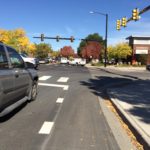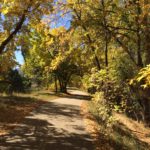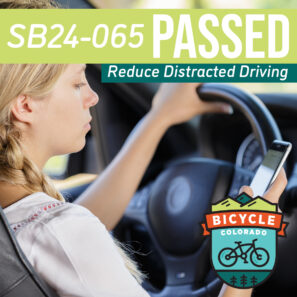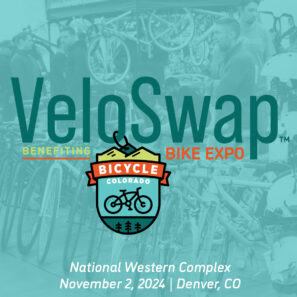Serenity now!
I know when you work in the field of bicycle advocacy and active transportation, you’re bound to hear these types of comments frequently. But as cyclists, we’ve all been there. Right?
Wait, been where? You know, that moment when a conversation turns awkward or uncomfortable by a comment (often) made by a non-cyclist with regard to bikes sharing the road.
And so it begins
Recently, I was at a business lunch in Boulder and had an ‘encounter’ that gave me pause for thought. The conversation started out innocently enough. A retired teacher asked me what I did for work and then upon learning, asked me what “all that green paint was doing on the road” at a particular intersection in town.

I explained that it was a high-conflict intersection with cars for both people on bikes and pedestrians, and that the paint was there to alert drivers that cyclists may continue straight through the intersection and to look for them before turning right.
She then asked if it was legal for bikes to ride alongside cars in a bike lane near an intersection. I said that indeed it was and that, sure, drivers may occasionally have to wait “about 4 seconds” for a person on a bike to get through the intersection before turning.
Her response? “Those 4 seconds can really add up over a lifetime in terms of wasted time and gas.”
Sigh.
This is the ‘there’ I’m referring to. A place that can trigger any number of responses, many of which are not well thought out, appropriate for printing here or, frankly, productive.
What’s next

So what is the best way to respond to folks who are hopefully well-meaning but uninformed drivers? For me it first depends on whether or not I think I have the chance of winning the person over and if they’re open to new information. If I assess that they will never really be open to seeing another perspective, I try to move on respectfully but quickly. Life’s too short.
Everyone has their own communication style they’re comfortable with, but here are some ways to respond that I’ve found to be informative and not intentionally antagonistic:
- First, I try to stay calm. While many of us are very passionate about bicycling and can easily have our buttons pushed, it’s generally best to maintain a clear, calm head. Otherwise my own answers can be knee-jerk and not optimal coming from a public representative of a bike advocacy group. Best to avoid that!
- Generally, I talk to the ‘why,’ not the ‘what.’ People respond to stories, not facts.
- Having said that, I think it’s good to have a few simple stats or anecdotes memorized that are meaningful, but I don’t get all technical.
- I try to convey that for the most part, we all just want to get where we’re going safely and efficiently by the mode of transportation we choose.
- I explain that the better the bicycling facilities, the more people will ride. When more people ride bikes, there are fewer cars and less congestion on the roads. We all win.
- The main point I try to make is that roads are public spaces, there for everyone to use. I’m not on your road; we’re on our road.
- Lastly, know when to say when. I try to educate people but don’t try to arm wrestle them to the ground to prove my point. And who knows? What you say today may resonate with them down the road when they first see their grandchild on a bike, or something similarly meaningful to them.

So this is what I do (in theory at least), after I’ve taken a deep breath and reminded myself that we’re talking about bicycles, which are so joyful. I’m curious to hear what works for others as you wade through these conversations. Please share your ideas in the comments below.
Leave A COMMENT
Our twitter feed is unavailable right now.









COMMENTS (2)
Ben -
In an instant, those four seconds can cost a lot in terms of human life.
Amy Morfas -
Ben, sorry for the delay in replying. That was the exact first thought to cross my mind…and the first response I gave.